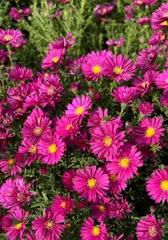As a common indoor potted plant, Dutch aster not only has ornamental value but also certain health benefits. It can increase indoor air humidity, purify the air, relieve stress, and promote sleep. Let's learn about the characteristics and care techniques of Dutch aster together.

Overview of Dutch Aster
Dutch aster, also known as Tim aster, is a common indoor potted plant belonging to the Asteraceae family. With its rich and colorful flowers, complex flower shapes, and delicate fragrance, it is a very popular indoor potted plant.
Characteristics of Dutch Aster
1. Dutch aster likes light but fears heat, requiring high light exposure and ensuring sufficient daily sunshine.

2. Dutch aster likes moisture but cannot tolerate waterlogging, so attention should be paid to controlling watering during maintenance to prevent overly wet soil.
3. Dutch aster prefers a hot and humid environment, but excessively dry climates will cause its leaves to turn yellow.
4. Dutch aster grows rapidly and needs timely pruning and shaping to maintain an aesthetically pleasing plant form.

5. Dutch aster has certain health benefits, such as relieving stress, promoting sleep, and purifying air.
Care Techniques for Dutch Aster
1. Light: Dutch aster likes light but fears heat, requiring sufficient daily sunshine. In spring and autumn, it's best to place Dutch aster outdoors for ample sunlight. During summer heat, it can be placed in partial shade.
2. Watering: Dutch aster likes moisture but cannot tolerate waterlogging, so attention should be paid to controlling watering to prevent overly wet soil. Before each watering, confirm that the soil surface is dry, and avoid watering on the leaves.
3. Humidity: Dutch aster prefers a hot and humid environment, so you can place a humidity tray under the pot or put the pot in a water tray to keep the soil moist and maintain ambient humidity.
4. Fertilization: Dutch aster grows rapidly and needs timely fertilization. Apply organic fertilizer or nutrient solution every two weeks during the growing season.
5. Spraying: The leaves of Dutch aster need to be kept clean, so you can spray water on the leaf surfaces daily with a sprayer to maintain cleanliness.
6. Pruning: Dutch aster grows rapidly and needs timely pruning and shaping to maintain an aesthetically pleasing plant form. You can prune and shape it as needed without letting it become too dense.
7. Thinning Flowers: When Dutch aster blooms, thinning flowers in time is necessary to avoid energy waste and impact on plant growth.
8. Pest and Disease Control: Dutch aster is relatively susceptible to pests and diseases such as powdery mildew and aphids. Problems should be detected early and appropriate control measures taken.
Uses of Dutch Aster
Dutch aster can not only serve as an indoor potted plant but also as raw material for fresh cut flowers and dried flowers. Its flower language is "eternal true love," making it a good choice for expressing love.
Precautions for Dutch Aster
1. Dutch aster likes moisture but cannot tolerate waterlogging, so attention should be paid to controlling watering during maintenance to avoid overly wet soil.
2. Dutch aster is relatively cold-tolerant but cannot withstand high temperatures; it should be placed in partial shade during summer to avoid scorching from heat.
3. Dutch aster requires high light intensity; prolonged placement in dark areas can easily lead to pest and disease problems.
4. Dutch aster dislikes frequent relocation; if moving the potted plant is necessary, it should be done in spring or autumn.
5. Dutch aster needs timely thinning when blooming to avoid energy waste and impact on plant growth.
Dutch aster is a very suitable indoor potted plant with both ornamental value and health benefits. During maintenance, attention should be paid to controlling watering, maintaining sufficient sunlight and temperature/humidity, and timely pruning and shaping to keep the plant aesthetically pleasing.
<|end_of_box|>